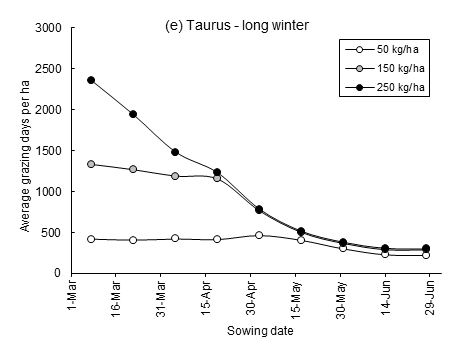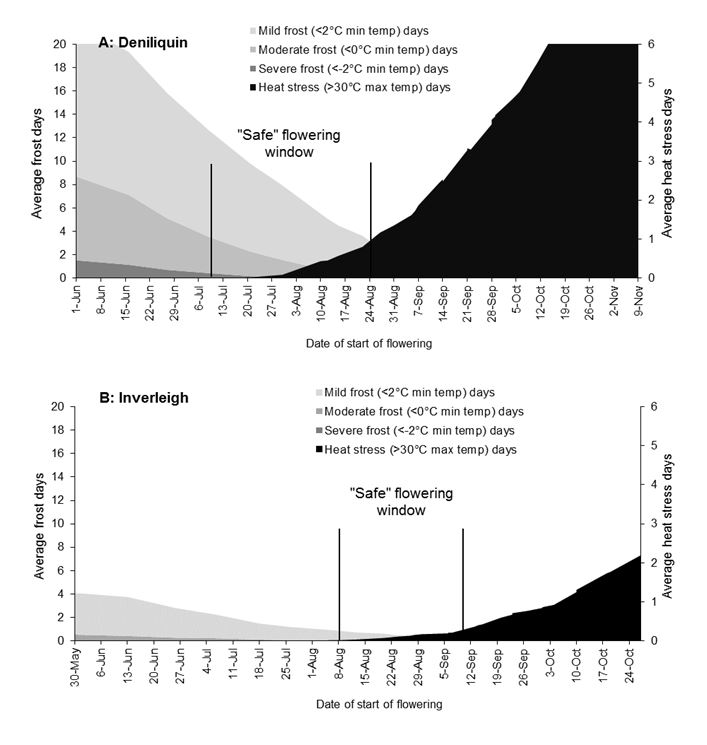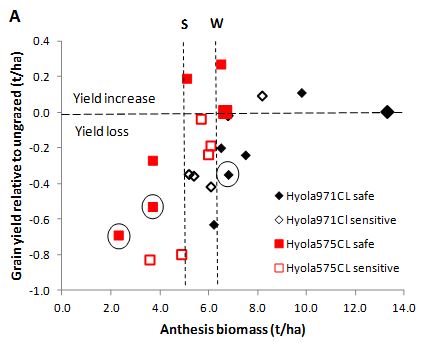Winter canola for grazing and grain production
Author: Annieka Paridaen (Premier Ag Consultancy Group Pty Ltd), Susie Sprague, John Kirkegaard and Julianne Lilley (CSIRO Agriculture, Canberra). | Date: 28 Jul 2016
Background
Dual-purpose crops have become an integral part of mixed farming systems in the medium and high rainfall zones of southern Australia. Winter canola cultivars that require a period of cold (vernalisation) to initiate flowering provide a wide sowing window from early spring through to early autumn and under suitable conditions, can be grazed six to eight weeks after sowing. Although production of dual-purpose winter canola was initially adopted in the high rainfall zones, changing rainfall patterns providing good early sowing opportunities has resulted in growers planting dual-purpose crops in March. Early-sown crops provide significant periods of grazing (up to 3000 sheep grazing days/ha) and can produce good grain yield as a result of the ability to access to moisture by development of deep roots. Dual-purpose crops can also reduce risk by providing income from grazing and grain as well as broader whole-farm benefits.
We present a discussion of the key management decisions around the use of dual-purpose winter canola. Implications for introduction into the irrigated region of southern NSW are presented in relation to experiments and grower experiences in the medium and high rainfall zones of southern Australia.
Management decisions
Sowing time - how early is too early?
- Winter canola requires cold temperatures (vernalisation) to initiate flowering which provides a wide sowing window from early spring through to early autumn.
- Sowing in early spring requires care in choosing the correct sowing time to avoid accruing part of the crops’ requirement for vernalisation in the first spring. Premature vernalisation could lead to early flowering in the following season thereby exposing the crop to severe frost risk.
- Evidence from experiments in the high rainfall zone (HRZ) that have experienced extreme summer conditions suggest that the crop should follow the same principles, however, some experimental work would be prudent before cropping on a larger scale under irrigation.
Plant establishment
- Aim for high plant numbers (>50plants/m2) as plants are lost during summer, whether grazed or not.
- High plant numbers maximise forage production during summer and autumn but also allow the crop to recover soil cover more rapidly to reduce weed issues.
Crop nutrition – when and how much?
- Canola is very responsive to nutrition. Adequate levels of up-front nitrogen (N) can substantially increase forage production (Figure 1).
- Apply N either up-front or post-grazing to avoid the possibility of nitrate poisoning in grazing livestock.
- Grazing stock recycle the majority of N to the paddock, however, not all of this may be immediately available to the crop. If sowing very early with high biomass production, multiple applications of N may be required to maximise forage and aid crop recovery from grazing. As a rule of thumb, canola requires 80kg N/t grain yield.

Figure 1: Effect of nitrogen at a variety of sowing times on the amount of grazing achieved for the winter canola cultivar Taurus at Young, NSW.
Grazing management – how long and how hard?
- Residual biomass and timing of lock-up is critical so crops have sufficient time to recover from prolonged grazing to maximise grain yield. Late and/or heavy grazing can delay flowering leading to exposure to heat stress.
- The grazing strategy will vary depending on the sowing time. Spring-sown canola grazed multiple times during spring and summer should be locked up in early autumn. Late summer/early autumn sown crops should be locked up prior to stem elongation.
Optimal flowering time to reduce frost and heat risk
The optimal flowering window minimises exposure to both frost and heat stress events. Although canola can compensate for such events due to its indeterminate flowering, severe weather events during the sensitive stage after the start of flowering can result in major yield loss. Yield reductions can range from 10 per cent per day for severe frosts (<-2C) up to 35 per cemt for heat stress events for temperatures >36C. Temperatures >29C can result in flower sterility. In the irrigation area of southern NSW, it is the risk of severe heat stress events that will most likely impact on the yield of winter canola. At Deniliquin, historical data indicates that canola starting to flower between 10 July and 25 August will avoid severe weather events (Figure 2A). In contrast to Deniliquin, the safe window for the start of flowering at Inverleigh, VIC, where numerous spring-sown winter canola experiments have been conducted, is between 8 August and 10 September with very little risk of either frost or heat if flowering begins outside this window (Figure 2B).
There is no regional-specific data available on the flowering time of winter canola in the irrigation region of southern NSW where winter conditions are relatively mild compared to those experienced in the medium-high rainfall rainfed cropping systems where experimental work has been conducted. Flowering of winter canola in experiments in other regions of Australia with mild winter conditions result in delayed onset of flowering and in some extreme cases, no flower development.

Figure 2: Frequency of frost and heat events in the ~6 week period after flowering commences when the crop if most sensitive. The ‘safe’ window for the start of flowering is indicated based on historical weather data for Deniliquin, NSW (A) and Inverleigh VIC (B).
Understanding the relationship between biomass and grain yield
The yield potential of any grain crop is related to the biomass at anthesis to support grain-filling.
The yield achieved then depends on conditions during flowering and grain fill to realise the potential.
In dual-purpose crops, the biomass at lock-up needs to be sufficient for the crop to recover to a level of biomass at flowering to achieve the target yield:
Residual Biomass at Lock-up <=> Critical Biomass at Flowering <=> Target Yield.
In irrigated crops, the risk of water stress during flowering can be mitigated. Therefore the high potential grain yield of irrigated canola needs to be supported by adequate biomass at flowering. In a grazed crop, the level of residual biomass and the timing of lock-up need to occur such that the crop can recover sufficient biomass at flowering and also to ensure that flowering is not delayed into heat stress conditions.
In experiments conducted at Greenethorpe, NSW, we have used different times and intensity of grazing in spring and winter canola to investigate grain yield recovery in dual-purpose crops. An example of this is Hyola®970CL sown on 25 March (Figure 3) which had a grain yield of 2.8t/ha after a very dry spring finish. The ungrazed winter canola generated 13.3t/ha biomass at flowering, but only ~6.5t/ha was required in grazed treatments to achieve the same yield (Figure 3). Yield penalties occurred when crops were severely defoliated as they failed to reach critical flowering biomass. Interestingly, the winter canola treatment grazed hard at bud visible in a ‘safe’ window (treatment circled in Figure 3) resulted in yield penalties despite recovering to the critical flowering biomass, probably because flowering was delayed into unfavourable conditions. A general rule of thumb for winter canola is that each 1t/ha of grain yield needs ~ 2.2t/ha of biomass at flowering (i.e. 3t/ha crop needs 6.6t/ha biomass at flowering, etc).

Figure 3: Flowering (anthesis) biomass of grazing treatments with a range of residual biomass levels and subsequent relative grain yield (% of ungrazed) achieved in winter canola Hyola®971CL (diamond, W) sown 25 March and spring canola Hyola®575CL (square, S) sown 23 April in experiments at Greenethorpe, NSW, in 2013. Defoliation treatments in the ‘safe’ window prior to stem elongation are indicated by closed symbols and those in the ‘sensitive’ window around the start of stem elongation by open symbols. Dashed vertical lines indicate critical flowering biomass for each cultivar to maintain yield similar to ungrazed controls (larger symbols). Circled symbols show hard treatments at bud visible that had reduced yield.
Sowing winter habit canola in spring and summer- results from the field
Conventional grazing of canola in the Victorian HRZ provides valuable winter fodder, yet often at the expense of grain yield come harvest. With the introduction of varieties with a vernalisation requirement, such as Edimax CL, Hyola®970 CL and Brazzil, spring sowing and grazing over the summer/autumn period can fill the feed gap with little impact on subsequent grain yield, as well as provide other options for management of problem paddocks.
In spring 2011, Southern Farming Systems set out to answer some key questions relating to grazing spring sown canola. How many times can it be grazed before a yield penalty is suffered? Should I graze it lightly or can I graze it as heavily as my cereals? Does nitrogen application following grazing enable better recovery?
Quality of feed on offer was high throughout the grazing period. Metabolisable energy (ME) averaged 13.5MJ/kg DM and protein was up around 22 per cent. Nitrate poisoning was not of concern, with levels well under the toxic threshold of 1000mg/kg for lambs. In saying that, introducing stock to forage brassicas needs to be done gradually; it is important that stock are not put out on canola with an empty stomach and they perhaps should be supplied with some roughage when grazing.
Table 1: Dry matter production and grain yield for spring sown Taurus canola at Dunkeld in 2012.
| Grazing (no). | Intensity of grazing | Grazing times | Days grazed | DM consumed cumulative (kg/ha) | Grain yield (t/ha) |
|---|---|---|---|---|---|
| 1 | Light | 31 Jan - 22 Feb | 22 | 494 | 2.8 |
| Heavy | 31 Jan - 5 Mar | 34 | 2316 | 2.5 | |
| 2 |
Light |
31 Jan - 22 Feb | 29 | 2763 | 2.9 |
| 29 Mar - 5 Apr | |||||
| Heavy | 31 Jan - 5 Mar | 46 | 2944 | 2.5 | |
| 29 Mar -10 Apr | |||||
| 3 | Light | 31 Jan - 22 Feb | 36 | 3488 | 2.7 |
| 29 Mar - 5 Apr | |||||
| 26 Apr - 3 May | |||||
| Heavy | 31 Jan - 5 Mar | 55 | 4031 | 2.4 | |
| 29 Mar - 10 Apr | |||||
| 26 Apr - 7 May | |||||
| LSD (p=0.05) | NS | ||||
| Sown in Spring, ungrazed | 1.9 | ||||
| Sown in Autumn, ungrazed | 2.3 | ||||
In 2012, grazing over summer increased grain yield compared to no grazing (Table 1). Ungrazed spring-sown canola yielded 1.9t/ha with optimal grazing going 2.7t/ha. Taurus sown at the conventional time (April) yielded 2.3t/ha. Observations were that plants that were grazed had branched more and produced a denser canopy with stems producing pods for grain.
The number of times the crop was grazed had a small effect on yield. Grazing twice produced the best result, yielding 0.1t/ha more than grazing once and 0.2t/ha more than grazing three times. Although there was a yield penalty by grazing three times compared to two times, the third grazing supplied an additional 1t/ha of high quality feed at the beginning of May.
Heavy grazing reduced yield compared to light grazing irrespective of the number of times it was grazed. However the reduction in yield was small and the heavy grazing produced 4t/ha of feed compared to 1.4t/ha when lightly grazed. When deciding on stocking rate and grazing intensity, it can be a trade-off between the value of the feed over summer and autumn and final grain yield suggesting that attitude and preference will vary between growers.
Applying nitrogen over summer had no yield benefits except for multiple (three) heavy grazings. In this case yield increased from 2.0t/ha to 2.7t/ha when 150kg/ha of urea was spread after each grazing. This would suggest that an application of fertiliser purely to boost crop performance is not necessary.
Dry matter production and yield 2013
The 2013 season was almost completely opposite to 2012, with extremely dry and hot conditions from sowing until the break in May 2013. Table 2 shows that dry matter production was down on 2012 (over a tonne less feed) however the value of the green feed in 2013 would most likely outweigh the extra tonne in the favourable 2012 season. It is difficult to put a price on almost three tonne of high quality green feed when there is nothing else around!
Resilience of the canola was well and truly tested, with three very heavy grazings occurring between the end of January and the end of April. There were plants lost and for a while it looked like nothing was going to grow back, however the thick starchy stem and root system of the established canola allowed the plants to hang on, and begin to grow leaves back once the break finally came. The recovery of the plants was just astounding; in winter 2013 you wouldn’t have believed what the area looked like only three months before.
Table 2: Dry matter production and grain yield for several winter canola varieties sown in spring 2012 and harvested in December 2013, Inverleigh VIC.
| Variety | Time of sowing | Grazing | Spring estab (pl/m2) | Autumn survival (pl/m2) | Reduction in plants (%) | Summer DM (t/ha) | Grain yield Manual harvest (t/ha) |
|---|---|---|---|---|---|---|---|
| Taurus |
Spring | Grazed | 47 | 26 | -43% | 2.5 | 4.0 |
| Ungrazed | 42 | 30 | -29% | 5.0 | |||
| Autumn | 8 | 3.6 | |||||
| Hyola®971CL | Spring | Grazed | 41 | 28 | -28% | 2.4 | 4.6 |
| Ungrazed | 42 | 28 | -28% | 5.2 | |||
| Autumn | 14 | 4.4 | |||||
| Hyola®930 | Spring | Grazed | 42 | 26 | -38% | 2.2 | 4.9 |
| Ungrazed | 39 | 36 | -4% | 5.2 | |||
| Autumn | 11 | 4.1 | |||||
| CB 143 CL | Spring | Grazed | 43 | 24 | -44% | 2.3 | 4.2 |
| Ungrazed | 38 | 30 | -18% | 4.5 | |||
| Autumn | 17 | 3.9 | |||||
| CB Sherpa | Spring | Grazed | 38 | 24 | -35% | 2.8 | 4.7 |
| Ungrazed | 43 | 27 | -36% | 5.2 | |||
| Autumn | Not sown | - | |||||
| Winfred rape | Spring | Grazed | 62 | 31 | -49% | 2.8 | - |
| LSD (p=0.05) | 12 | 7 | NS | NS | 0.8 | ||
Conclusion
Canola can be a useful dual purpose crop in mixed farming businesses if suitable varieties are selected and sown in their optimum window. Vernalisation requirements in winter habit canola mean that they can be sown very early in the autumn or even in springtime the year before, provide valuable grazing and carry on to be a productive cash crop. Winter canola has proven to be a very resilient plant when it comes to heat and dry periods over summer and autumn. Careful management of these paddocks, especially sowing time, grazing management, lock up dates and nutrition requirements will see these rotations become a valuable part of a mixed farming enterprise.
Useful resources
GRDC Update paper February 2015 Turning sowing times on their head with winter habit canola and wheat
GRDC Update paper February 2016 Managing dual purpose crops to optimise profit from grazing and grain yield
GRDC Update paper August 2015 Optimising grain yield and grazing potential of dual purpose crops
Acknowledgements
The research undertaken as part of this project is made possible by the significant contributions of growers through both trial cooperation and the support of the GRDC. The authors would like to thank Rod Kershaw, Iandra for the use of land in 2013 and 2014 and Peter Hamblin and staff at Kalyx Australia (Young) for management of the field experiments at Greenethorpe. Acknowledgements also must be given to the two host farmers of the Southern Farming Systems research trials from 2011 to 2013. Doug McArthur, Dunkeld and Rowan Peel, Inverleigh.
Contact details
Annieka ParidaenPremier Ag Consultancy Group
PO Box 2152 Grovedale, VIC 3216
0439 339 433
annieka@premierag.com.au
@AParidaen
Susie Sprague
CSIRO Agriculture and Food
PO Box 1700, Canberra, ACT 2600
0466 643 227
Susan.Sprague@csiro.au
Was this page helpful?
YOUR FEEDBACK
